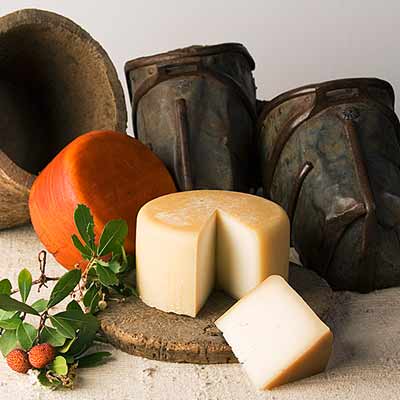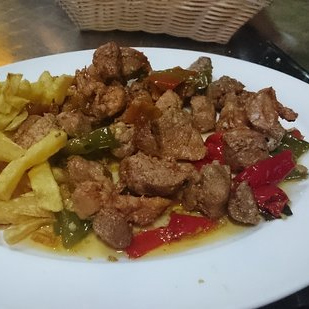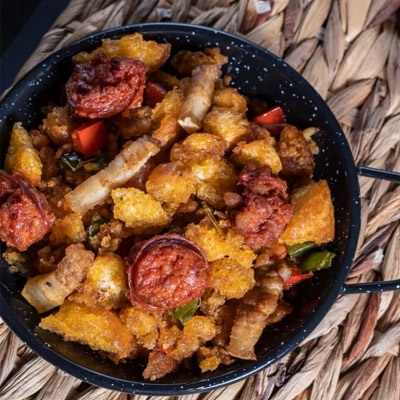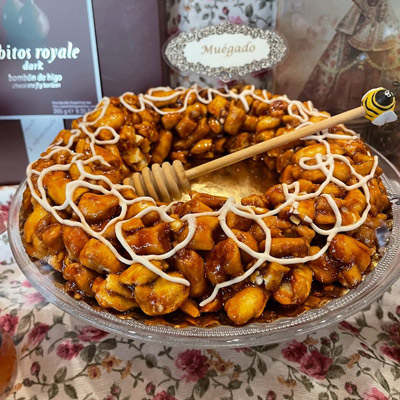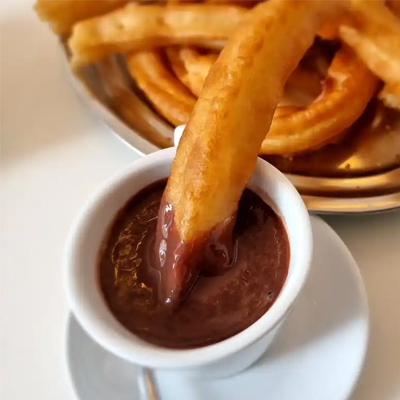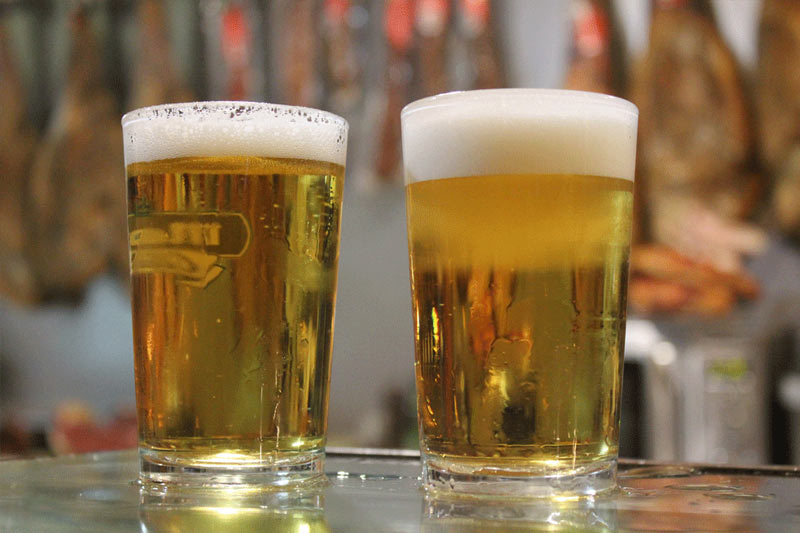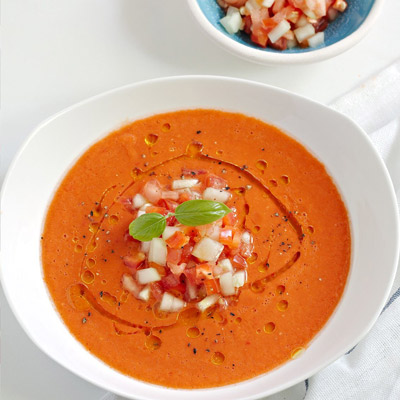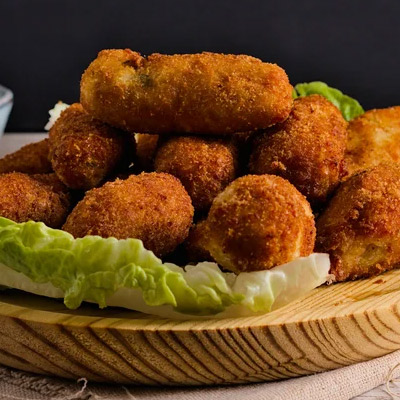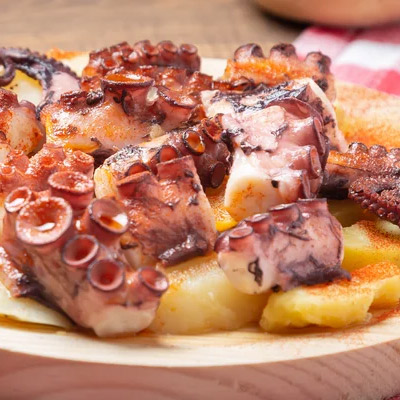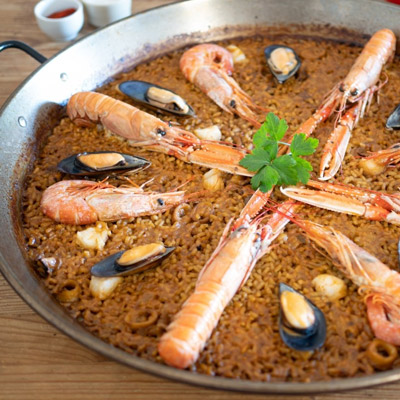Warning: you may start salivating
Spanish gastronomy is a celebration of life, love, and the joy of sharing good food with friends and family. Alvaro has curated this page with a list of dishes to try and places to visit, as well as some must know about the culinary culture in Spain.
Must try in Guadalupe
Morcilla
(Blood sausage)
This sausage typical of Guadalupe is one of those delicacies which you just can’t miss. It is made from pork and cabbage, with regular or spicy variants. You can try at any restaurant in Guadalupe.
Queso de los Ibores
(Ibores cheese)
Forget the Manchego! This is a delicious goat’s cheese, with a semi-hard rind, ivory in colour, rubbed with paprika or in oil. Its name comes from the county where the largest concentrations of goats are reared.
Lomo ibérico
(Dry cured loin)
Instead of minced meat, like Salami or Chorizo, Lomo is made from the whole piece of Ibérico de Bellota pork loin. Its characteristic aroma and profound flavour along with its marbled fat make it unique.
Picadillo
(Bull stew)
A delicious slow cook stew with an explosion of flavour. Usually served with fries or boiled potatoes, the meat will melt in your mouth.
Migas Extremeñas
(Fried breadcrumbs with meat and peppers)
Originally a shepherd’s dish prepared over an open fire, it usually includes garlic, fried peppers, pork belly and chorizo. Certainly not recommended for sensitive bellies.
Dulces típicos
(Traditional pastry)
Very close to Alvaro’s heart (and palate), his grandmother worked in the local pastry shop and Alvaro used to help during his summer holidays as a child. Top picks: muégado, almendrados and perrunillas.
Porras
(Fried dough)
If you like churros get ready to experience porras! A thicker version of a similar fried dough. All-night Spanish benders usually end with a 6am visit to the churreria. You can try them at El Abuelo in Guadalupe.
Aceite de oliva
(Olive oil)
You will notice that Guadalupe is surrounded by vast fields of olive trees, extra virgin olive oil is produced locally. The best way to try it? Pour it over some freshly made local bread.
Places to go in Guadalupe
You can find all locations in our Guadalupe POIs map
- Posada del Rincón – great for tapas, lunch and dinner. You can eat on the main square terrace, inside or on their interior patio.
- Restaurante Jorda – located next to the Arco Sevilla, you can enjoy typical local food, great for large meat and fish dishes.
- Hospederia del Monasterio – This restaurant is located within the Monastery, more touristy and pricey, but you can eat in the Gothic cloister.
- Las Ánimas del Tiempo Restaurante – classic homemade food with very affordable lunch set menus.
- Café Atrium – this is the place to go for coffee and pastries during the day, and a quiet gin and tonic at night.
- Churrería El Abuelo – must go to try the porras (churros)
- Panaderia Pascual – for traditional bread and pastries.
Must do: enjoy some cañas and tapas at one of the terraces on the Main Square in front of the Monastery.
You should know...
There are no cañas without tapas, or tapas without cañas.
Las cañas
“Ir de cañas” (go for cañas) is a social ritual in Spain, usually around 1-2pm before lunch and/or 6-9pm before dinner, gathering in bars or terraces to enjoy some beers, wines or non-alcoholic drinks. Una caña is normally a small glass (200ml) of tap beer, usually Lager, like San Miguel, Mahou, Estrella or Cruzcampo. The generic name for beer is cerveza, if you don’t specify format you will likely get a caña or a copa (cup). Other ways to order beer are “un doble” (tap beer in a larger glass or cup), “un tercio” (a 33cl bottled beer) or “una jarra” (usually a 0.5l jar)
Las tapas
It is believed that the term “tapa” originated in the 13th Century, when King Alfonso X ordered that taverns should not serve wine without some food, preventing alcohol from affecting the guests too much. Usually a slice of cured meat, it was placed on top of the drink, thus acquiring the name “tapa” (lid). Today tapas is a very generic term used for any traditional food served in small plates/portions. When you order cañas you will usually get complimentary tapas. It is also custom to have lunch by ordering and sharing tapas, or raciones, which are larger portions.
Must try in Spain
Jamón Ibérico
(Cured ham)
Iberian pigs are slow-growing animals because they aren’t given hormones or fattened on industrial corn. They have a unique diet, foraging in meadows for grubs, grasses, and nuts, and later feasting on acorns. This diet gives their fat a nutty flavour and high oleic acid content, similar to olives.
Gazpacho
(Tomato soup)
This tomato-based Andalusian soup is most famous for being served cold, and consumed only in summer. Its principal ingredients, aside from tomato, are peppers, garlic, bread and olive oil.
Croquetas
(Fried nuggets of thick béchamel sauce)
The ultimate Spanish croqueta is filled with jamón serrano. It’s the perfect combination of creamy béchamel, crispy-fried coating, and salty-savory ham.
Tortilla Española
(Spanish omelet)
Omelet filled with potatoes and onions that have been poached in olive oil. Potatoes didn’t become popular as food for humans until the 1800s, which is when the first written record of the tortilla Española appears.
Pintxos Vascos
(Basque pinchos)
This is a generic category similar to tapas – pinchos can be hot or cold, ‘spiked’ with a toothpick to a piece of bread. Originating in the Basque region you can enjoy pinchos all over Spain. I would recommend Asador Imanol in Madrid
Boquerones en vinagre
(Anchovies)
Spanish-style fresh anchovies are larger and meatier than the smaller and darker cured ones, and don’t have the intense salt kick that the preserved ones do.
Pulpo a la Gallega
(Galician octopus)
Bite-size pieces of boiled octopus, garnished with boiled sliced potatoes, olive oil, salt, and paprika. Although it originated in Galicia (North West of Spain) you can find it all over the country.
Pimientos de Padrón
(Fried peppers)
Salty, slightly sweet, and scorched in extra virgin olive oil. Eating pimientos de padrón is a game of chance. Most of the time, the charred peppers have a bold yet mild flavour but sometimes the heat level can pack a serious punch.
Fabada Asturiana
(Asturian bean stew)
Asturian faba beans are very large, similarly shaped to cannellini beans, and have a subtle buttery flavour. The stew is usually loaded with other mouthwatering ingredients like pork shoulder, chorizo, or morcilla.
Paella
(Rice dish)
Originally from the Valencian Community, Paella is one of the best-known dishes in Spanish cuisine. There are dozens of variations, the most common being veggies only, meat and veggies, seafood paella and squid ink paella.



